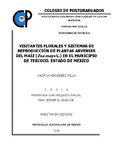| dc.description.abstract | Las plantas silvestres que crecen en los cultivos se conocen como arvenses. En México alrededor de un 13% de la flora (aproximadamente 3000 especies) son consideradas plantas arvenses o ruderales. El cultivo de maíz en Mesoamérica posee una flora arvense muy diversa con una alta proporción de especies nativas. Muchas de estas especies tienen flores vistosas, presumiblemente orientadas hacia una polinización por animales, mientras que las arvenses del Viejo Mundo se autopolinizan o se polinizan por el viento. Se ha mostrado que el espectro de adaptaciones a la dispersión de las arvenses mesoamericanas es distinta a otras floras arvenses. Para explorar más la ecología de la reproducción de la flora arvense mesoamericana, el objetivo de este trabajo fue estudiar los visitantes florales y los sistemas de reproducción de plantas arvenses asociadas al cultivo de maíz, en dos sitios del municipio de Texcoco, México. En cada uno se seleccionaron cinco arvenses comunes y nativas, a las cuales, se les determinó su sistema de reproducción (autógamo obligado o facultativo/ alógamo obligado), tipos de visitantes florales, y la calidad de las semillas resultantes. También se consideró la altura de la planta. Para determinar el sistema de reproducción, se aplicaron dos tratamientos a 12 inflorescencias de las especies estudiadas: embolsamiento antes de antesis, y polinización abierta. Se separaron las semillas vanas y llenas de cada tratamiento y se contaron; se analizaron los resultados con ANOVAS y pruebas de Tukey. Se encontraron tres especies preferentemente alógamas (Tithonia tubiformis (Jacq.) Cass., Simsia amplexicaulis (Cav.) Pers., Bidens odorata Cav.) que son de porte alto, dos autógamas obligadas (Acalypha mexicana Müller Arg y Dyssodia papposa (Vent.) Hitchc.), de porte bajo, y cinco autógamas facultativas (Lopezia racemosa Cav., Salvia tiliifolia Vahl, Tinantia erecta (Jacq.) Schltdl., Galinsoga parviflora Cav. y Galinsoga quadriradiata Ruiz & Pav.), de porte medio. Solo 8 de las 10 especies (las altas y las medianas) recibieron visitas. Estas visitas fueron de diferentes grupos taxonómicos de insectos lo que sugiere que estas especies arvenses son generalistas; sin embargo, cada especie tenía su propio grupo de visitantes. Hubo una relación marcada y altamente significativa entre el número de visitas y la altura: a mayor altura había un mayor número de visitas. También hubo una diferencia entre los dos sitios: en el sitio más rural, ocurrieron más visitantes y más especies obligadamente alógamas que en el cultivo de maíz en los campos experimentales del Colegio de Postgraduados. En conclusión, sí se encontró un número relativamente alto de especies obligadamente alógamas, comparado con otras floras arvenses, y parece que existe una relación muy cercana entre accesibilidad (altura) y el número de visitas. En nuestra muestra, no encontramos una proporción mayor de semillas llenas bajo polinización cruzada en las especies facultativamente autógamas. _______________ FLORAL VISITORS AND BREEDING SYSTEMS OF MAIZE (Zea mays L.) WEEDS IN THE MUNICIPALITY OF TEXCOCO, MEXICO STATE. ABSTRACT: Wild plants that grow in crops are known as agrestal weeds. In Mexico about 13% of the flora (approximately 3000 species) are considered agrestal or ruderal weeds. Maize crops in Mesoamerica have a very diverse weed flora with a high proportion of native species. Many of these species have colorful flowers, presumably oriented towards animal pollination, while Old World weeds self-pollinate or are pollinated by the wind. It has been shown previously that the spectrum of adaptations to dispersal of Mesoamerican weeds is different from other weed floras. To further explore the reproductive ecology of the Mesoamerican weed flora, the objective of this work was to study the floral visitors and the breeding systems of weeds associated with maize, in two localities of the municipality of Texcoco, Mexico. In each one five common and native weeds were selected. Then, their breeding system (obligate or facultative autogamous or obligate allogamous), types of floral visitors, and the quality of the resulting seeds were determined. Also, the size of the plants was considered. To determine the breeding system, two treatments were applied to 12 inflorescences of the studied species: bagging before anthesis, and open pollination. The seeds were separated into empty and filled, and counted for each treatment; the data were analyzed with ANOVAS and Tukey tests. Three preferentially allogamous species were found (Tithonia tubiformis (Jacq.) Cass., Simsia amplexicaulis (Cav.) Pers., Bidens odorata Cav.), which were tall species, two obligate self-pollinated species (Acalypha mexicana Müller Arg and Dyssodia papposa (Vent.) Hitchc.), small plants, and five facultative autogamous ones (Lopezia racemosa Cav., Salvia tiliifolia Vahl, Tinantia erecta (Jacq.) Schltdl., Galinsoga parviflora Cav. and Galinsoga quadriradiata Ruiz & Pav.), of medium height. Only 8 of the 10 species (the tall and medium-sized ones) received visits. These visits were from different taxonomic groups of insects which suggests that these weed species are generalists; however, each species had its own set of visitors. The relationship between size and number of visitors was strong and highly significant statistically: taller plants had more visitors. There was also a difference between the two sites: in the more rural site, there were more visitors and more cross-pollinated species than in the maize fields of the experimental areas of the Postgraduate College. The species in the two sites were completely different. In conclusion, a relatively high number of obligate allogamous species was found, compared with other weed floras, and it seems that there is a very close relationship between accessibility (stature) and the number of visits. In our sample, autogamous pollination did not lead to less viable seeds than cross-pollination in facultatively autogamous species. | es_MX |


